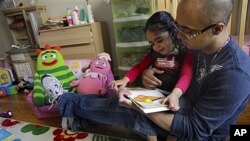The number of American children diagnosed with autism has been increasing steadily -- from one-in-110 youngsters in 2006 to one-in-88 in 2008. The findings are based on a new study by the U.S. government that looked at the prevalence of autism, a developmental disorder that usually appears in the first few years of life and affects brain development and communication skills.
Autism shows up as a range of behaviors. Some children have a mild version, called Asperger’s syndrome, that makes them seem awkward in social settings. Others are severely affected, with extreme social and communication difficulties marked by repetitive behaviors and withdrawal from contact with other people.
The U.S. Centers for Disease Control and Prevention, or CDC, in Atlanta, assessed surveillance data about 8-year-old children from fourteen states that was collected in 2008. It found that for every 1,000 children, more than 11 were diagnosed with autism. According to the CDC, almost five times as many boys were affected -- 1 in 54.
CDC Director Thomas Frieden says the increase in reported autism cases might be due to improved recognition of the disorder.
"Doctors have gotten better at diagnosing the condition," said Frieden. "Communities have gotten better at providing services, so at this point I think there is the possibility of that the increase in identification is entirely the result of better detection."
Because autism usually appears in the first three years of life, the CDC is calling for early and frequent screenings of children, beginning at 18 months of age, and again at 24 and 30 months of age.
Susan Hayman, who heads the autism subcommittee of the American Academy of Pediatrics, said waiting until a child is 4 years old to be evaluated for autism is too late, because early therapeutic intervention can help affected children learn to lead relatively normal lives.
“Children who aren’t pointing, who aren’t making eye contact with communication may have autism, but they may have other things," said Hayman, explaining that parents should immediately seek diagnosis if they notice certain behaviors in toddlers. "It’s important for parents who have concerns to bring them up."
The leading autism advocacy group in the United States, Autism Speaks, has said the developmental disorder knows no boundaries, and the group estimates about 67-million people around the world are affected by autism.
News
Study: Autism on the Rise Among US Children










